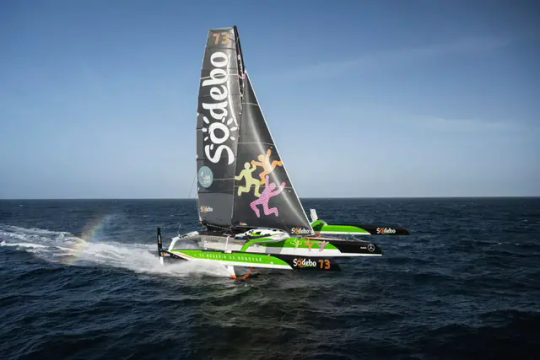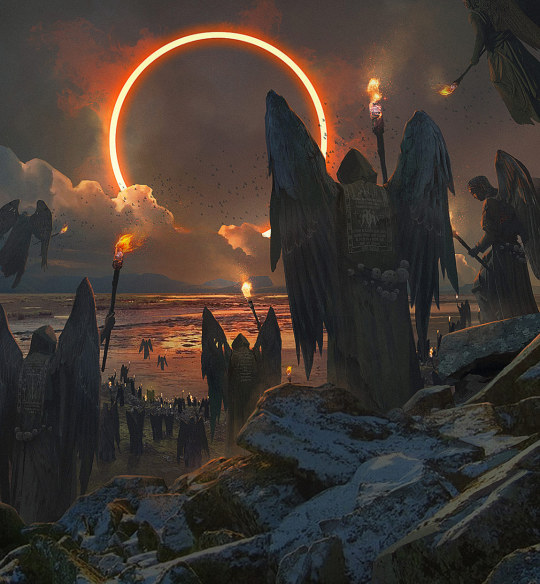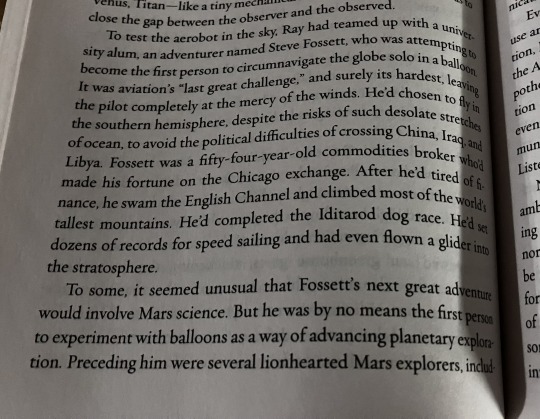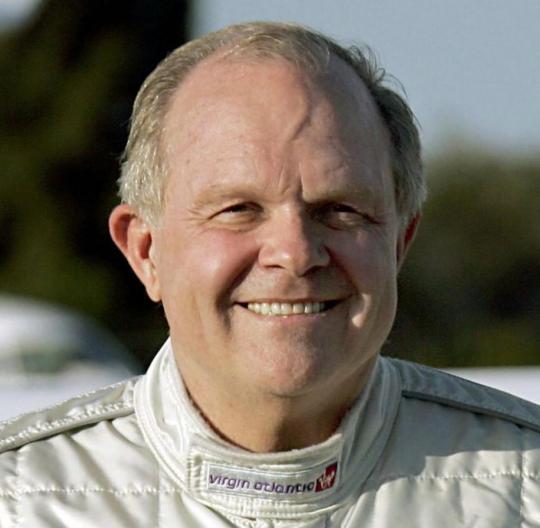#Steve Fossett
Text
youtube
Racing the Distance
It’s weird to think that the late-90s competition to be the first to circumnavigate (and then later to do it solo) the world in a balloon is something I might have to explain to younger people because it absolutely WAS a big deal at the time, and even for ten years afterwards it was the go-to joke about Richard Branson. I don’t know if the most recent renovation of the National Air and Space Museum still has either Breitling Orbiter 3 or Spirit of Freedom on display anymore.
2 notes
·
View notes
Text
youtube
Alle Menschen sind gleich? – Die Erfahrung in dieser Welt lehrt uns doch: Wohl kaum!
Wenn Du Jesus antworten möchtest, aber nicht weißt wie, dann nimm doch Kontakt mit uns auf oder nutze unser Info- und Seelsorgetelefon.
https://GOTT.BiZ – Glaube von seiner besten Seite!
0 notes
Text
In July 2002, the US aviator Steve Fossett circumnavigated the globe alone in which form of aircraft?

In 2002, Steve Fossett circumnavigated the globe in a hot-air balloon called 'Spirit of Freedom' to become the first successful around-the-world nonstop solo flight in any kind of aircraft. On 19th June, Fossett set off from Northam, Western Australia, and landed in Queensland, Australia, on 3rd July. The flight lasted 13 days, 8 hours, 33 minutes and covered 20,626.48 miles (33,195.10 km).
The 'Spirit of Freedom' was designed by Donald Cameron of Cameron Balloons Ltd. of Bristol, England. The technology to produce a balloon that could safely circumnavigate the globe took seven years to complete. During this period, Fossett made several attempts to make the journey. In 1996, he travelled from South Dakota to Canada, and in 2007, he managed to travel from Australia to Brazil.
James Stephen "Steve" Fossett (1944-2007) was an American businessman and adventurer. On 3rd September 2007, Fossett went missing while flying a light aircraft over the Great Basin Desert. A year later, his remains and part of his aircraft were found in the Sierra Nevada mountain range in California.
0 notes
Text
Events 3.3 (after 1930)
1931 – The United States adopts The Star-Spangled Banner as its national anthem.
1938 – Oil is discovered in Saudi Arabia.
1939 – In Bombay, Mohandas Gandhi begins a hunger strike in protest at the autocratic rule in British India.
1940 – Five people are killed in an arson attack on the offices of the communist newspaper Flamman in Luleå, Sweden.
1942 – World War II: Ten Japanese warplanes raid Broome, Western Australia, killing more than 100 people.
1943 – World War II: In London, 173 people are killed in a crush while trying to enter an air-raid shelter at Bethnal Green tube station.
1944 – The Order of Nakhimov and Order of Ushakov are instituted in USSR as the highest naval awards.
1944 – A freight train carrying stowaway passengers stalls in a tunnel shortly after departing from Balvano, Basilicata, Italy just after midnight, with 517 dying from carbon monoxide poisoning.
1945 – World War II: In poor visibility, the RAF mistakenly bombs the Bezuidenhout area of The Hague, Netherlands, killing 511 people.[8]
1953 – A De Havilland Comet (Canadian Pacific Air Lines) crashes in Karachi, Pakistan, killing 11.
1958 – Nuri al-Said becomes Prime Minister of Iraq for the eighth time.
1969 – Apollo program: NASA launches Apollo 9 to test the lunar module.
1972 – Mohawk Airlines Flight 405 crashes as a result of a control malfunction and insufficient training in emergency procedures.
1974 – Turkish Airlines Flight 981 crashes at Ermenonville near Paris, France killing all 346 aboard.
1980 – The USS Nautilus is decommissioned and stricken from the Naval Vessel Register.
1985 – Arthur Scargill declares that the National Union of Mineworkers' national executive voted to end the longest-running industrial dispute in Great Britain without any peace deal over pit closures.
1985 – A magnitude 8.3 earthquake strikes the Valparaíso Region of Chile, killing 177 and leaving nearly a million people homeless.
1986 – The Australia Act 1986 commences, causing Australia to become fully independent from the United Kingdom.
1991 – An amateur video captures the beating of Rodney King by Los Angeles police officers.
1991 – United Airlines Flight 585 crashes on its final approach to Colorado Springs killing everyone on board.
2005 – James Roszko murders four Royal Canadian Mounted Police constables during a drug bust at his property in Rochfort Bridge, Alberta, then commits suicide. This is the deadliest peace-time incident for the RCMP since 1885 and the North-West Rebellion.
2005 – Steve Fossett becomes the first person to fly an airplane non-stop around the world solo without refueling.
2005 – Margaret Wilson is elected as Speaker of the New Zealand House of Representatives, beginning a period lasting until August 23, 2006, where all the highest political offices (including Elizabeth II as Head of State), were occupied by women, making New Zealand the first country for this to occur.
2013 – A bomb blast in Karachi, Pakistan, kills at least 45 people and injured 180 others in a predominantly Shia Muslim area.
2017 – The Nintendo Switch releases worldwide.
0 notes
Text
Only bought them so you could take them off
read it on the AO3 at https://ift.tt/sQpbx8l
by coagulo (rya_204)
Steve alzò gli occhi dal foglio. C’era un rosa pastello che spuntava oltre l’orlo di quei jeans, un ricamo in pizzo annidato sotto le fossette alla base della sua schiena. Steve contrasse le dita e attese. Erano solo al primo paio di jeans, Bucky ne avrebbe provati altri.
> La storia partecipa alla challenge “Forza 4 red challenge” indetta da Fuuma sul forum Torre di Carta.
Words: 1438, Chapters: 1/1, Language: Italiano
Fandoms: Marvel Cinematic Universe, Captain America (Movies)
Rating: Explicit
Warnings: No Archive Warnings Apply
Categories: M/M
Characters: James "Bucky" Barnes, Steve Rogers
Relationships: James "Bucky" Barnes/Steve Rogers
Additional Tags: Alternate Universe - Modern Setting, Wet & Messy, Crossdressing, Intercrural Sex, Frottage, Smut & Devotion
read it on the AO3 at https://ift.tt/sQpbx8l
0 notes
Text
Ill-Fated Titan Submersible Was Based on an Unproven Design

OceanGate’s CEO and founder Stockton Rush had a problem. He wanted to take passengers to see the Titanic shipwreck. They would pay an enormous amount of money ($250,000/person) for the opportunity. But the wreck lay on the ocean floor almost 4,000 meters below the surface and his passenger-carrying submersible could only go to a depth of 500 meters. The pressure at 4,000 would crush the Cyclops fa
A video from WABASH using a tanker trailer, a shell with stiffener rings, which shows the speed and suddenness of an implosion. The severity at the depths the Titan was at would have caused a much greater pressure differential, but its walls were thicker than the tanker trailer’s. Also, the behavior of carbon fiber in an implosion is far different than it is for metal and it is uncertain whether the collapsed carbon fiber hull would have stayed in one piece. Video: YouTube.
But the swashbuckling Rush, a former commercial pilot with an aerospace engineering degree, had a solution: a thick wall cylinder held together with carbon fiber composite. Why not? Carbon fiber had worked for the Boeing 787 Dreamliner.
Never mind that every deep ocean submersible before it had shied away from carbon fiber for behavior in compression that is problematic and unpredictable. Some had been quite outspoken about using the material. Rush prided himself on breaking rules.
The task of designing the carbon fiber-enforced hull, now under scrutiny as a likely cause of the submersible’s failure, fell to Spencer Composites, led by Brian Spencer. Spencer, with his multiple engineering degrees, including a PhD from the University of Nebraska in engineering mechanics and publications galore, was an expert on filament winding, a technique he had already applied to many a land-based and aerospace product—and most important to this story—for Steve Fossett’s DeepFlight Challenger, so named because it appeared to be more like an airplane than a submersible.
Millionaire adventurer Steve Fossett, who was the first to fly a hot-air balloon around the world and the first to fly around the world without refueling, was already a legend. He planned to add to his achievements by going to the bottom of the Mariana Trench, the deepest known point in the ocean, past 19,500 meters.
Fossett was given the task of designing a carbon fiber hull for the DeepFlight Challenger. Spencer had analyzed it using COSMOS/M, by Structural Research and Analysis Corp (now incorporated into Dassault Systèmes and branded SOLIDWORKS Simulation). He had built it on a 4-axis CNC machine adapted for filament winding.
The result, a simple-looking thick-walled cylindrical pressure chamber (with the pressure on the outside, of course) in which Fossett was to lie hid a carefully placed network of carbon fibers, each placed precisely either tangentially or axially to the cylinder. Spencer’s composite design for the hull involved alternate double layers of wound carbon fiber around a core (acting against the compressive hoop stress) and a layer of fibers laid axially (against the compressive axial stress that would develop from the pressure on the hemispherical endcaps, according to a 2010 CompositesWorld.
Similarities to the carbon fiber composite in this video of the Titan’s hull are similar to what was described in the design of Fossett’s DeepFlight Challenger: 2 layers of wound carbon fiber for each layer of axially oriented fiber. Video: OceanGate via YouTube.
Because Spencer Composites was contracted a few years later by OceanGate to design the hull of the Cyclops 2 (renamed the Titan), we will assume the same wound and axial fiber composite design was used in OceanGate’s carbon fiber hulls1. A big difference, and perhaps a fatal one, is the DeepFlight Challenger needed to accommodate only one person, so it would have had less surface area, and therefore less compressive forces due to pressure, even though was designed to go to depths 5x deeper than the Titan.
Never mind that the DeepFlight Challenger’s use of a carbon fiber hull was unproven. Spencer had to use the same carbon fiber construction it had suggested for the DeepFlight Challenger for OceanGate’s submersibles. And the clock was ticking. Spencer was given 6 weeks and told he had to meet a few design constraints—a length of 2.54 m, 1.676 m outside diameter, service pressure of 6,600 psi (roughly the pressure at 4,000 meters), and a safety factor of 2.25, according to a 2017 article in CompositeWorld.
Spencer Composites’ first design of the OceanGate submersible used carbon fiber for all the structure, the hemispherical endcaps as well as the cylindrical body, according to an interview with Rush found on the University of Washington’s website. The Applied Physics Laboratory at the University of Washington, Seattle, near OceanGate’s headquarters (which Rush referred to as OceanGate’s “engineering partner”) ran pressure tests on a scale model of the Titan with carbon fiber cylinder and was at the time considering making all of the Titan’s main structure out of carbon fiber, including the hemispheric domes. However, the carbon fiber domes failed, letting water through at 3,000 meters. This probably led to the titanium domes that were actually used in the Titan.
0 notes
Text
When wealthy adventurers take huge risks, who should foot the bill for rescue attempts?
When millionaire Steve Fossett’s plane went missing over the Nevada range in 2007, the swashbuckling adventurer had already been the subject of two prior emergency rescue operations thousands of miles apart.
And that prompted a prickly question: After a sweeping search for the wealthy risktaker ended, who should foot the bill?
In recent days, the massive hunt for a submersible vehicle lost during…

View On WordPress
0 notes
Text
Thomas Coville et le Team Sodebo Voile à la conquête de la route de la découverte

La saison 2023 a démarré pour l'équipe Sodebo Voile, avec pour objectif de battre le record de la Route de la Découverte. Thomas Coville fera une première tentative en équipage, puis s'élancera pour une seconde en solitaire. Depuis le 7 janvier, et jusqu'au 7 avril prochain, l'équipe est sur le pont pour évaluer la meilleure fenêtre météorologique pour s'élancer de Cadix (Espagne) et atteindre San Salvador (Bahamas). Le premier temps à battre en mode équipage est de 6 jours, 14 heures, 29 minutes et 21 secondes.
Pour cette tentative de record, en équipage, Thomas Coville a choisi de partir avec 5 équipiers d'expérience, qui connaissent le bateau, et se connaissent. Il s'agit de Thomas Rouxel, Guillaume Pirouelle, Nicolas Troussel, François Duguet, Léonard Legrand.
A terre, la cellule routage, composée de Philippe Legros et Will Oxley, est active et scrute tous les jours l'évolution des conditions météo, dans ses moindres détails.
Qu'est-ce que la Route de la Découverte?

crédit Vincent Curutchet / Team Sodebo
Ce parcours de 3884 milles de l'orthodromie (7193km), reliant la ville de Cadix en Espagne à San Salvador, aux Bahamas, retrace le parcours de l'expédition de Christophe Colomb qui a conduit à la découverte de l'Amérique en 1492. Avec ses 3 embarcations, la Pinta, la Nina et la Santa Maria, le navigateur génois a effectué ce voyage transatlantique en 70 jours.
Depuis lors, cette Route de la Découverte est très convoitée dans le monde de la course en mer, en particulier depuis la fin du XXème siècle. En 1984, c'est Philippe Poupon, à bord de Fleury Michon VII, qui remporte la première édition, à laquelle 30 équipages ont pris le départ. D'abord une course en équipage entre Cadix et Saint-Domingue, cette Route de la Découverte a évolué progressivement pour être utilisée en dehors des courses, pour l'un des nombreux records transatlantiques reconnus par le World Speed Sailing Record Council (WSSRC).
Temps à battre: Détenteur du record en équipage par Serge Madec en 1988, Grand Dalton en 2000, Steve Fossett en 2003 et Franck Cammas en 2007, ce record de la Route de la Découverte est actuellement détenu par Yann Guichard et son équipage (dont Thomas Rouxel) qui en 2013 ont traversé l'Atlantique en 6 jours, 14 heures, 29 minutes et 21 secondes. En solitaire, le record est détenu par Armel le Cléach qui a effectué ce parcours en 6 jours, 23 heures, 42 minutes et 18 secondes en janvier 2014.
Comment est prise la décision du départ?
https://youtu.be/VdZ7CbRw3ms
Jusqu’au 7 avril prochain, le team et la cellule routage sont en recherche de la meilleure fenêtre météo, permettant de battre le record de cette Route de la Découverte. Pour mieux comprendre cette période et savoir si Sodebo Ultim 3 s’élancera sur le parcours, plusieurs codes couleurs, en reprenant les bonshommes dessinés dans les voiles de Sodebo Ultim 3, ont été mis en place pour communiquer et donner une tendance :
- Code Violet : « Stand-by » : La cellule routage et l’équipage attendent une « fenêtre météo » pour considérer un départ et tenter de battre le record de 7193 km détendu par Spindrift en 6 jours, 14 heures, 29 minutes et 21 secondes.
- Code Orange : S’il est activé, c’est qu’il existe une fenêtre potentielle pour tenter de battre le record. Sodebo Ultim 3 quittera son port d’attache à Lorient pour rallier la zone de départ, à Cadix en Espagne.
- Code Vert : Lorsque que la cellule routage et le skipper Thomas Coville, décideront que la fenêtre météo est opportune, alors ça sera un départ imminent pour Sodebo Ultim 3 et son équipage.
Phot de couverture: crédit Vincent Curutchet / Team Sodebo
Read the full article
1 note
·
View note
Text




LAS IMAGENES DEL DIA 2 DE JULIO DE 2022
Día Mundial de los OVNIs, Día Internacional del Periodista Deportivo y Día Internacional de las Cooperativas.
San Otón de Bamberg y Santa Monegunda.
Tal día como hoy en 1966: El gobierno de Francia ordena la detonación de su primera bomba atómica, 'Aldebarán', en el atolón de Mururoa (Polinesia Francesa). En 1947: Un objeto desconocido se estrella en un rancho de Roswell, Nuevo México (Estados Unidos), la versión oficial, sostenida por el ejército es que fue un globo aerostático, pero según algunos testigos presenciales, fue una nave de origen extraterrestre lo que se estrelló. Desde entonces el hecho ha dado lugar a toda una serie de de teorías de conspiración. En 1897: El inventor italiano Guglielmo Marconi patenta la radio en Londres (Reino Unido), pero Nikola Tesla ya lo había hecho antes en la misma ciudad. En el 2002: Steve Fossett se convierte en la primera persona que da la vuelta al mundo en globo aerostático en solitario y sin realizar escalas. En 1964: El presidente de Estados Unidos, Lyndon B. Johnson, firma un decreto que termina con el apartheid estadounidense, el sistema de segregación racial. Y en 1950: El monje Hayashi Yoken, con problemas mentales, incendia el Templo del Pabellón de Oro (Kinkaku-ji), en Kioto (Japón) porque tenía envidia de su belleza. Fue construido en 1397 y varias veces había sido ya destruido antes.
Muchas más imágenes en http://obesia.com/miscelaneas
0 notes
Text

The “Most Unexpected Steve Fossett Guest Appearance of the Year” award goes to The Sirens of Mars and it’s not even close.
2 notes
·
View notes
Text
Events 2.21 (after 1920)
1921 – Constituent Assembly of the Democratic Republic of Georgia adopts the country's first constitution.
1921 – Rezā Shāh takes control of Tehran during a successful coup.
1925 – The New Yorker publishes its first issue.
1929 – In the first battle of the Warlord Rebellion in northeastern Shandong against the Nationalist government of China, a 24,000-strong rebel force led by Zhang Zongchang was defeated at Zhifu by 7,000 NRA troops.
1937 – The League of Nations bans foreign national "volunteers" in the Spanish Civil War.
1945 – World War II: During the Battle of Iwo Jima, Japanese kamikaze planes sink the escort carrier USS Bismarck Sea and damage the USS Saratoga.
1945 – World War II: the Brazilian Expeditionary Force defeat the German forces in the Battle of Monte Castello on the Italian front.
1947 – In New York City, Edwin Land demonstrates the first "instant camera", the Polaroid Land Camera, to a meeting of the Optical Society of America.
1948 – NASCAR is incorporated.
1952 – The British government, under Winston Churchill, abolishes identity cards in the UK to "set the people free".
1952 – The Bengali Language Movement protests occur at the University of Dhaka in East Pakistan (now Bangladesh).
1958 – The CND symbol, aka peace symbol, commissioned by the Direct Action Committee in protest against the Atomic Weapons Research Establishment, is designed and completed by Gerald Holtom.
1971 – The Convention on Psychotropic Substances is signed at Vienna.
1972 – United States President Richard Nixon visits China to normalize Sino-American relations.
1972 – The Soviet uncrewed spaceship Luna 20 lands on the Moon.
1973 – Over the Sinai Desert, Israeli fighter aircraft shoot down Libyan Arab Airlines Flight 114 jet killing 108 people.
1974 – The last Israeli soldiers leave the west bank of the Suez Canal pursuant to a truce with Egypt.
1975 – Watergate scandal: Former United States Attorney General John N. Mitchell and former White House aides H. R. Haldeman and John Ehrlichman are sentenced to prison.
1994 – Aldrich Ames is arrested by the Federal Bureau of Investigation for selling national secrets to the Soviet Union in Arlington County, Virginia.
1995 – Steve Fossett lands in Leader, Saskatchewan, Canada becoming the first person to make a solo flight across the Pacific Ocean in a balloon.
2013 – At least 17 people are killed and 119 injured following several bombings in the Indian city of Hyderabad.
2022 – In the Russo-Ukrainian crisis Russian President Vladimir Putin declares the Luhansk People's Republic and Donetsk People's Republic as independent from Ukraine, and moves troops into the region. The action is condemned by the United Nations.
0 notes
Text
26th November - On This Day In History
26th November – On This Day In History
Born:
1939 Tina Turner (singer)
Died:
2007 Steve Fossett (aviator)
On This Day:
1924 Mongolian People’s Republic formed
Have a good Sunday, 26th November
www.aromaticcoffees.co.uk
Please visit the above, and click out on a Google link – help me pay for the time it takes to makes these daily posts
View On WordPress
#adventure#asia#aviation#biscuits#coffee#education#entertainment#history#mongolia#music#rock#singer#steve fossett#tea#tina turner#USA
1 note
·
View note
Text
HOW TO LIVE ON THE EDGE.
LEARNING TO WALK THE FINE LINE BETWEEN PASSION AND INSANITY

Jumping off a cliff? Skydiving? Ok, hot air ballooning, maybe scaling the Everest. Perhaps even doing illegal shit that could put you behind bars.
Is that the idea of living on the edge? Or is it something else?
Do you need to be insane to live on the edge? Can everyone do it? Is it difficult? How do you do it? What exactly is it in the first place?
Living on the edge is simply one word.
ACTION.
It is about DOING things. Things that you love.
It is chasing your dreams, following them to the darkest places and yet never losing sight of them.
It is that fire, it is that passion, which makes your heart race and drum in your chest.
It is each moment so fantastic and explosive, yet filling you with a sense of peace and contentment.
It’s being scared, because of the unpredictability, yet excited at the endless possibilities.
It is going to bed exhausted every day, yet being happy about it.
Living on the edge is about having fun.
Every moment of our lives should be lived like that.
It’s easy to talk about living on the edge, but what about actually doing it?
Am I being realistic?
We need money to be able to survive and continue doing the things we love. Some of us can earn money by doing things we love, but most of us aren’t that fortunate. We don’t choose our passions based on their financial advantages now do we?
But wait a minute. Why am I saying that we can’t live on the edge by doing our jobs?
We need ACTION to live on the edge, right?
So here is where we go wrong.
We associate earning money with action.
The action consists of waking up every day, reaching the office, working harder and harder at our jobs, and coming back tired in the evening just to repeat the whole cycle again.
Because the ACTION in our lives becomes earning, we hate it.
Since we are drained, tired and uninspired, we naturally gravitate towards the complete opposite of ACTION aka INACTION, which we fondly call “chilling”.
We start associating “living the life” with INACTION. This could be things like binge-watching Netflix because you “totally deserve a break from work”, going on vacations, lying on the beach, and for a lot of people, just sleeping all day.
Our idea of happiness is to earn a lot of money, “retire early” and chill, sleeping on an island or something.
This is wrong. Think back to your 5-year-old self. This is not what they would want. They were full of dreams and ideas and plans and energy!
You owe it to yourself to live the life of your dreams.
Living on the edge is not “chilling” and it’s not working hard at your job just so you can get your paycheck. It’s not this kind of action, and it is definitely not inaction.
It is the ACTION of a totally different quality.
Action which is exciting, thrilling and life-changing. Meaningful, fulfilling and fun.
A story:

Steve Fossett was a madman. As of 1997, he was in his mid-fifties and had enjoyed a hugely successful career as a floor trader in Chicago, when he decided to see what he was capable of. ‘There was a period of time where I wasn’t doing anything except working for a living,’ he said. ‘I became very frustrated with that and finally made up my mind to start getting back into things.’
Between the mid-1990s and his death in 2007, Steve broke about 130 world records, 93 of them in planes, balloons and airships, 23 of them in yachts. He climbed the world’s highest mountains. He swam the English Channel. He learned to glide and, with co-pilot Terry Delore, broke ten of the 21 Glider Open Class Records. He learned how to fly a balloon, and was the first man to sail one around the world single-handed. (taken from Richard Branson’s book.)
He had hunger. He had passion. He lived on the edge. He could’ve stayed that floor trader in Chicago and watched TV on the weekends, but he did not. Even in his late fifties and sixties, he broke world records.

“My proceeds from the PayPal acquisition were $180 million. I put $100 million in SpaceX, $70m in Tesla, and $10m in Solar City. I had to borrow money for rent.” — Elon Musk.
He was rich. He didn’t need to lift a finger again to work. EVER. But he did. Why?
He just wanted to keep doing what he loved!
Elon is now a pioneer of cutting edge technology, brilliant innovation, and exciting ideas. His everyday work is literally to figure out how to make commercial space travel a reality, inspiring more 9-year olds to become astronauts in the process and to make Mars livable. By working on this, he is not only doing what he loves but also aiming to solve one of the major problems the world faces today.
Learn that new skill. Start that new business. Go for that trip you’ve been wanting to take for years. Move to that city. That book in your head? Put it down on paper. Start that blog and put that video out.
Life is too short. Live on the edge. DO things. Be in ACTION and never stop chasing your dreams and fulfilling your passions.
Not to endorse or anything, but Nike got it right.
Just do it.
#passion#living#livingontheedge#life#adventure#young#fire#excitement#thrill#elonmusk#steve fossett#richard branson#book#live#alive#fun#teen#travel#rich#money
0 notes
Photo

The Nevada Triangle
There is a triangle in Nevada that covers a vast area close to Area 51. More than 2000 planes have vanished, seemingly into thin air, with most of them never found. The most well-known missing plane and pilot story is the one that tells of billionaire Steve Fossett, a very experienced pilot who went missing on the California/Nevada border in 2007. The wreckage and some of Fossett’s remains were discovered a year later. The reason for the crash remains unknown, despite a multitude of theories, including downdrafts. Other disappearances in the Nevada Triangle include a B-24 bomber that went missing in 1943 and was found submerged in a reservoir in 1955. In 1957, another military plane went missing, and after an extensive but fruitless search, the plane’s pilot was declared dead. However, 54 days after the crash, the pilot pitched up in Kings Canyon National Park. He said something had unexpectedly exploded inside his plane, and he ejected from the plane. He survived on fish and hunted small animals for food until he eventually reached the park.
There are several theories on why the Nevada Triangle seems to swallow up planes, including aliens, mountain waves etc, but the truth is yet to be revealed.
60 notes
·
View notes
Photo

Sitemize "Virgin Galactic, Halka Açık İlk Uzay Turizmi Şirketi Olmaya Hazırlanıyor" konusu eklenmiştir. Detaylar için ziyaret ediniz. https://doctortekno.com/2019/10/26/virgin-galactic-halka-acik-ilk-uzay-turizmi-sirketi-olmaya-hazirlaniyor/
#virgin galactic spaceshiptwo#virgin galactic enterprise#virgin galactic eve#virgin galactic tier two#virgin galactic spirit of steve fossett
0 notes